Unit 1 Great Scientists warming up&speaking
文档属性
| 名称 | Unit 1 Great Scientists warming up&speaking | 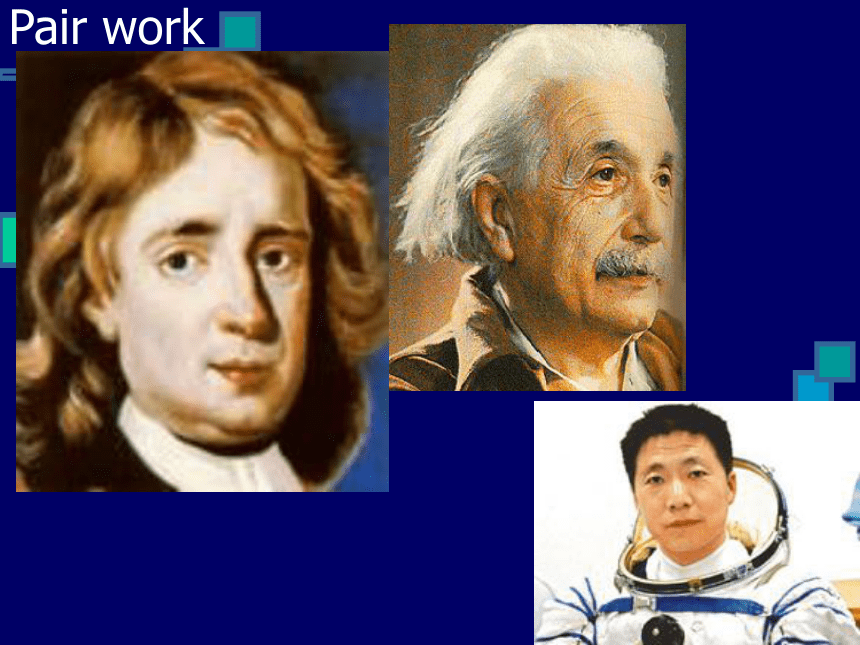 | |
| 格式 | zip | ||
| 文件大小 | 953.5KB | ||
| 资源类型 | 教案 | ||
| 版本资源 | 人教版(新课程标准) | ||
| 科目 | 英语 | ||
| 更新时间 | 2012-08-22 16:45:17 | ||
图片预览

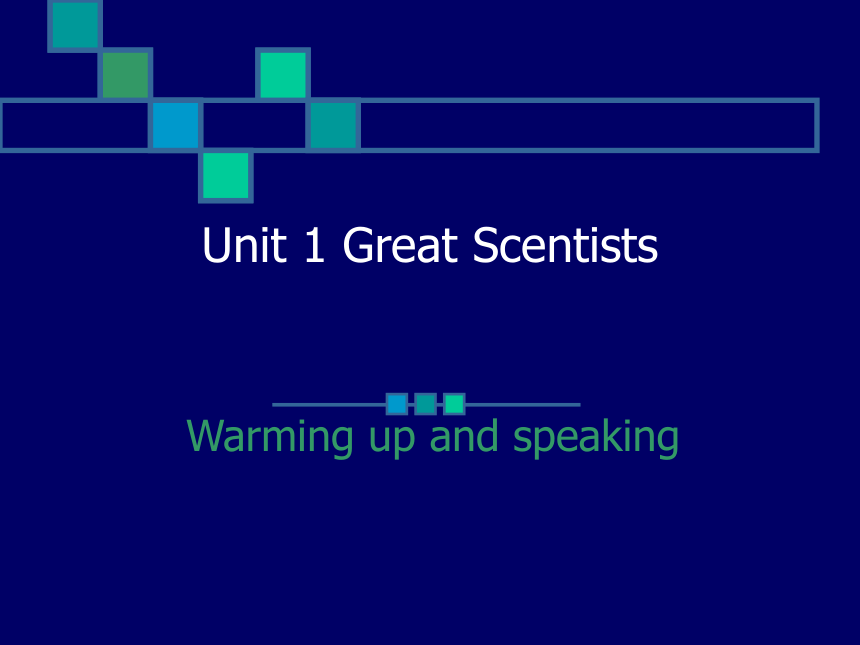


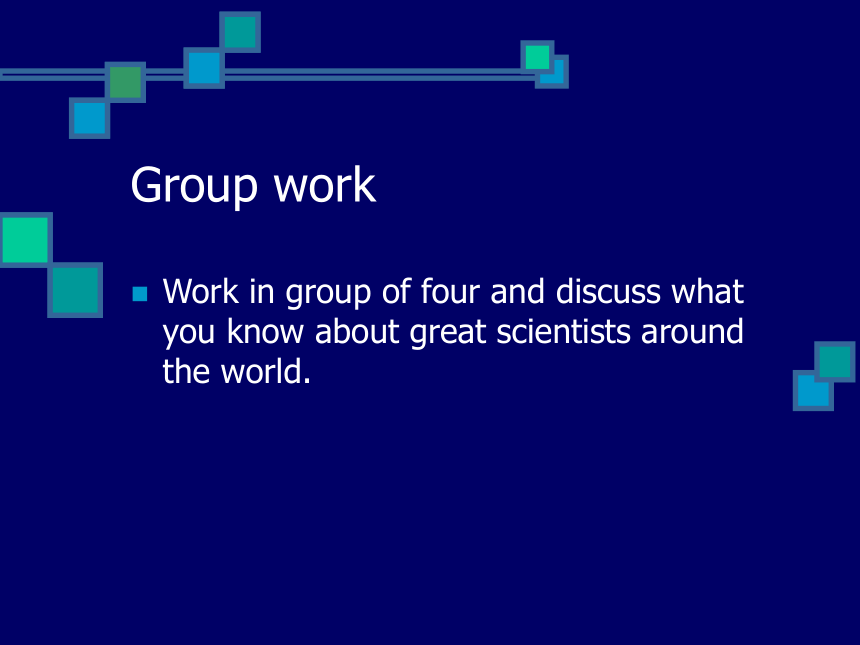
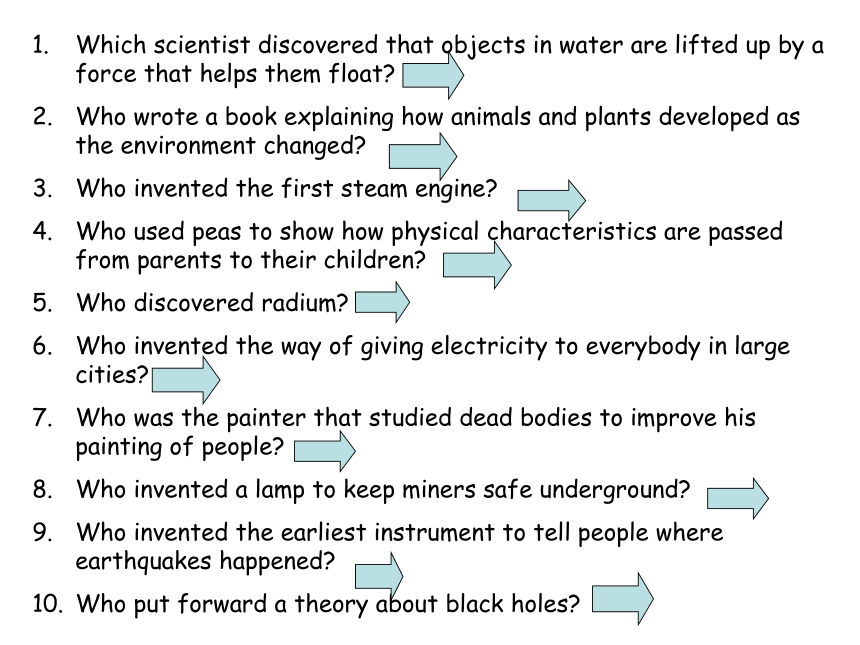
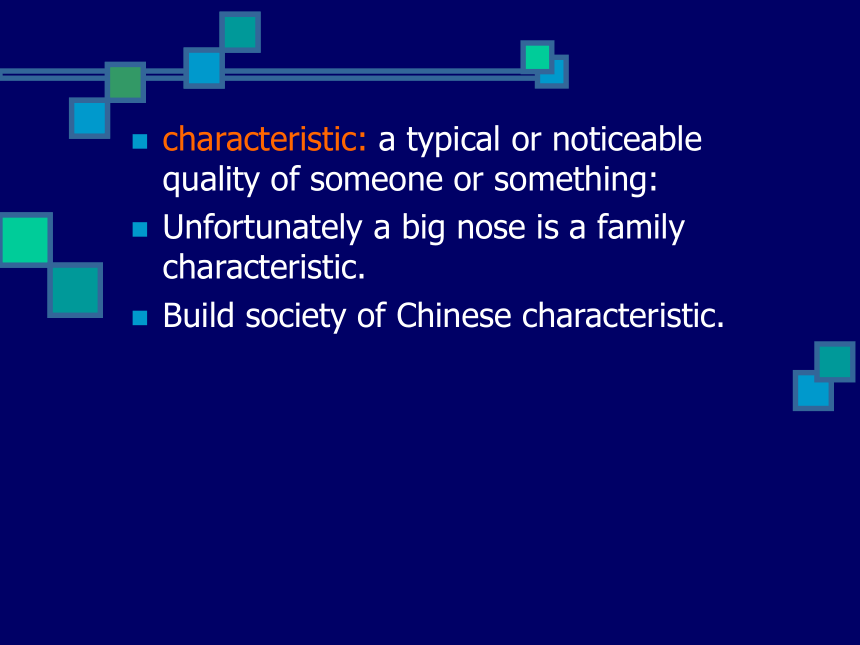

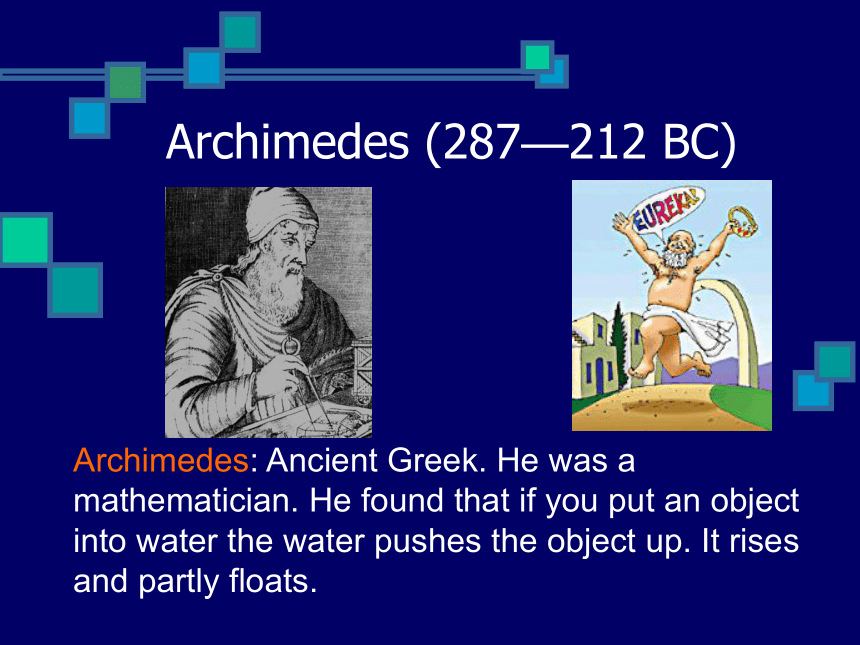
文档简介
(共22张PPT)
Pair work
Unit 1 Great Scentists
Warming up and speaking
Speaking
These questions may help you:
What job do you want to do
What personality will be needed Why
What education will you need
How long will the training take
How will you prepare for this career
These expressions may help you:
patient, creative, heard-working, co-operative, confident, brave, positive, determined, energetic, strict…
Group work
Work in group of four and discuss what you know about great scientists around the world.
Which scientist discovered that objects in water are lifted up by a force that helps them float
Who wrote a book explaining how animals and plants developed as the environment changed
Who invented the first steam engine
Who used peas to show how physical characteristics are passed from parents to their children
Who discovered radium
Who invented the way of giving electricity to everybody in large cities
Who was the painter that studied dead bodies to improve his painting of people
Who invented a lamp to keep miners safe underground
Who invented the earliest instrument to tell people where earthquakes happened
Who put forward a theory about black holes
characteristic: a typical or noticeable quality of someone or something:
Unfortunately a big nose is a family characteristic.
Build society of Chinese characteristic.
put forward: to state an idea or opinion, or to suggest a plan or person, for other people to consider.
The proposals that you have put forward deserve serious consideration.
I wasn't convinced by any of the arguments that he put forward.
Many suggestions have been put forward, but a decision is unlikely until after next year's general election.
Archimedes (287—212 BC)
Archimedes: Ancient Greek. He was a mathematician. He found that if you put an object into water the water pushes the object up. It rises and partly floats.
Give me a place to stand on, and I can move the earth. ----Archimedes
Charlie Darwin(1808-1882)
Britain naturalist. The Origin of Species was published in 1859. It explained how plants and animals had changed over time to fit in with a changing environment. His book showed that people had developed form apes.
Thomas Newcomen(1663—1729)
He improved the first steam pump built by Thomas Savery in 1689 and turned it into a steam engine for taking water out of mines in 1712. James Watt improved it still further in the 1770s turning it into the first modern steam engine used on the railways.
Gregor Mendel(1822—1884)
Gregor Mendel. Czech. The father of genetic. He grew pea plants and developed ideas on heredity and inherited characteristics. Between 1856—1863 he grew 28,000 pea plants. He examined seven kinds of seed and plant characteristics and developed some laws of inheritance.
Marie Curie (1867-1934) was born in Poland, moved to Paris and studied chemistry and physics there. She married Pierre Curie and together they studied radioactive materials and discovered radium. In 1911 she received the Nobel Prize in Chemistry. Her death in 1934 was almost certainly due to radiation in her work.
Thomas Edison(1847----1931)
He was already an inventor of other electrical devices (phonograph, electric light bulb) when in 1882 he designed a system for providing New York with electricity from a central power station. This was a tremendous achievement, which had previously been thought impossible.
Leonardo da Vinci(1452-----1519)
He was a famous Italian artist whose skill for showing human skin tones made his paintings seem to come alive. He used to study dead people in order to make his paintings as accurate as possible. Some of his famous paintings include “The smile of Mona Lisa” “The Last Supper”. Later in his life he lived in France where he designed a submarine and a flying machine.
Sir Humphry Davy(1778—1829)
British. He did research into different gases and discovered the medical value of nitrous oxide (laughing gas) as an anaesthetic. In 1815 he developed a safety lamp for miners.
Zhang Heng ,Chinese( 78-----139)
He invented the first seismograph to indicate in the direction of an earthquake. It was in the shape of a cylinder with eight dragonheads round the top, each with a ball in its mouth. Around the bottom were eight frogs directly under a dragon’s head. When an earthquake occurred, a ball fell out of the dragon’s mouth, making a noise.
Stephen Hawking,British(1942--- )
He has worked in astronomy and studied black holes in space. He has shown that black holes do not only absorb everything around them but, from time to time, throw out matter as well. This may mark the beginning of new galaxies. This is an advance on the old theory which said that black holes “eat” everything they come across.
Pair work
Unit 1 Great Scentists
Warming up and speaking
Speaking
These questions may help you:
What job do you want to do
What personality will be needed Why
What education will you need
How long will the training take
How will you prepare for this career
These expressions may help you:
patient, creative, heard-working, co-operative, confident, brave, positive, determined, energetic, strict…
Group work
Work in group of four and discuss what you know about great scientists around the world.
Which scientist discovered that objects in water are lifted up by a force that helps them float
Who wrote a book explaining how animals and plants developed as the environment changed
Who invented the first steam engine
Who used peas to show how physical characteristics are passed from parents to their children
Who discovered radium
Who invented the way of giving electricity to everybody in large cities
Who was the painter that studied dead bodies to improve his painting of people
Who invented a lamp to keep miners safe underground
Who invented the earliest instrument to tell people where earthquakes happened
Who put forward a theory about black holes
characteristic: a typical or noticeable quality of someone or something:
Unfortunately a big nose is a family characteristic.
Build society of Chinese characteristic.
put forward: to state an idea or opinion, or to suggest a plan or person, for other people to consider.
The proposals that you have put forward deserve serious consideration.
I wasn't convinced by any of the arguments that he put forward.
Many suggestions have been put forward, but a decision is unlikely until after next year's general election.
Archimedes (287—212 BC)
Archimedes: Ancient Greek. He was a mathematician. He found that if you put an object into water the water pushes the object up. It rises and partly floats.
Give me a place to stand on, and I can move the earth. ----Archimedes
Charlie Darwin(1808-1882)
Britain naturalist. The Origin of Species was published in 1859. It explained how plants and animals had changed over time to fit in with a changing environment. His book showed that people had developed form apes.
Thomas Newcomen(1663—1729)
He improved the first steam pump built by Thomas Savery in 1689 and turned it into a steam engine for taking water out of mines in 1712. James Watt improved it still further in the 1770s turning it into the first modern steam engine used on the railways.
Gregor Mendel(1822—1884)
Gregor Mendel. Czech. The father of genetic. He grew pea plants and developed ideas on heredity and inherited characteristics. Between 1856—1863 he grew 28,000 pea plants. He examined seven kinds of seed and plant characteristics and developed some laws of inheritance.
Marie Curie (1867-1934) was born in Poland, moved to Paris and studied chemistry and physics there. She married Pierre Curie and together they studied radioactive materials and discovered radium. In 1911 she received the Nobel Prize in Chemistry. Her death in 1934 was almost certainly due to radiation in her work.
Thomas Edison(1847----1931)
He was already an inventor of other electrical devices (phonograph, electric light bulb) when in 1882 he designed a system for providing New York with electricity from a central power station. This was a tremendous achievement, which had previously been thought impossible.
Leonardo da Vinci(1452-----1519)
He was a famous Italian artist whose skill for showing human skin tones made his paintings seem to come alive. He used to study dead people in order to make his paintings as accurate as possible. Some of his famous paintings include “The smile of Mona Lisa” “The Last Supper”. Later in his life he lived in France where he designed a submarine and a flying machine.
Sir Humphry Davy(1778—1829)
British. He did research into different gases and discovered the medical value of nitrous oxide (laughing gas) as an anaesthetic. In 1815 he developed a safety lamp for miners.
Zhang Heng ,Chinese( 78-----139)
He invented the first seismograph to indicate in the direction of an earthquake. It was in the shape of a cylinder with eight dragonheads round the top, each with a ball in its mouth. Around the bottom were eight frogs directly under a dragon’s head. When an earthquake occurred, a ball fell out of the dragon’s mouth, making a noise.
Stephen Hawking,British(1942--- )
He has worked in astronomy and studied black holes in space. He has shown that black holes do not only absorb everything around them but, from time to time, throw out matter as well. This may mark the beginning of new galaxies. This is an advance on the old theory which said that black holes “eat” everything they come across.
